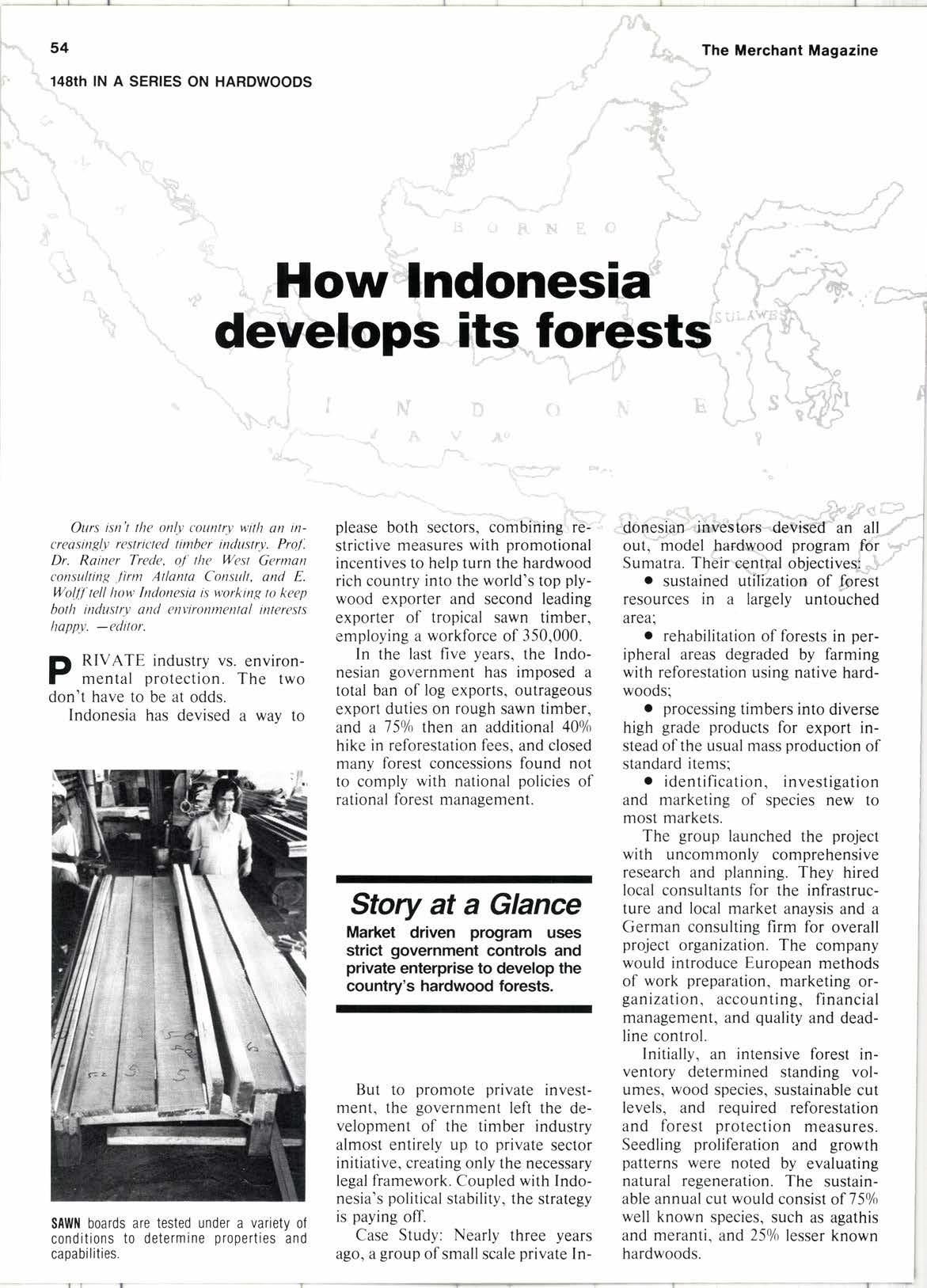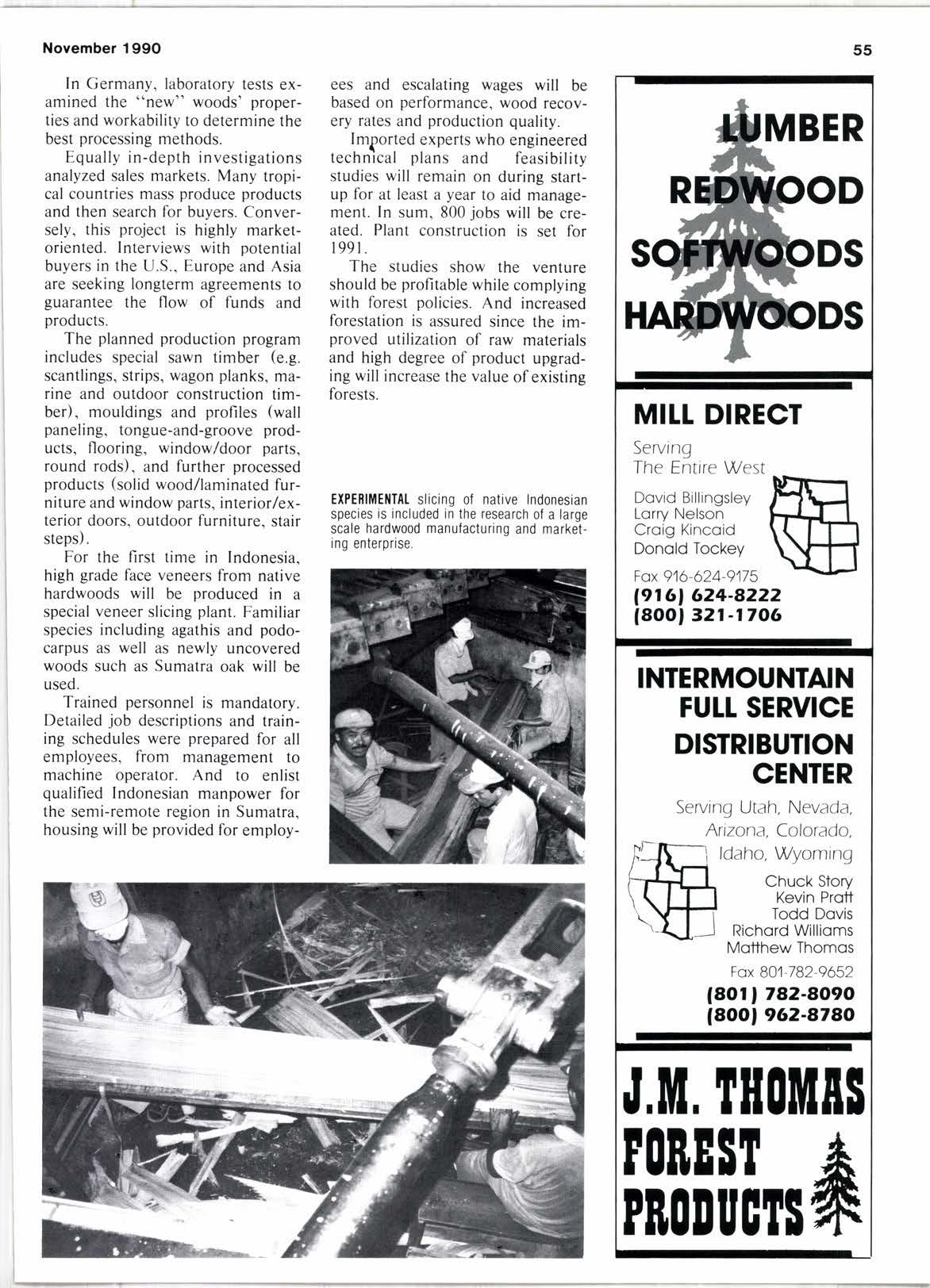
2 minute read
How',lndonesia deUelops its'forest$'
Ours isn't the only country \)ith an increasingly restricted timber industry. Prol. Dr. Rainer Trede, qf the West German consulting .firm Atlanta Consult, and E. WoUl tell how Indonesia is working to keep both industry and environmentol inlerests happy. -editor.
li RIVATE industry vs. F mental protection. don't have to be at odds. Indonesia has devised please both sectors, combining restrictive measures with promotional incentives to help turn the hardwood rich country into the world's top plywood exporter and second leading exporter of tropical sawn timber, employing a workforce of 350,000.
In the last five years, the Indonesian government has imposed a total ban of log exports, outrageous export duties on rough sawn timber, and a 7 5o/o then an additional 40% hike in reforestation fees, and closed many forest concessions found not to comply with national policies of rational forest management.
Story at a Glance
Market driven program uses strict government controls and private enterprise to develop the country's hardwood forests.
But to promote private investment, the government left the development of the timber industry almost entirely up to private sector initiative, creating only the necessary legal framework. Coupled with Indonesia's political stability, the strategy is paying off.
Case Study: Nearly three years ago, a group of small scale private In- out, ""irodel hardwood program fior ;- Sumatra. Their eenttal objectiveql_,,:-
. sustained utilization of .fprest resources in a largely untouched areal o rehabilitation of forests in peripheral areas degraded by farming with reforestation using native hardwoods; o processing timbers into diverse high grade products for export instead of the usual mass production of standard items; o identification, investigation and marketing of species new to most markets.
The group launched the project with uncommonly comprehensive research and planning. They hired local consultants for the infrastructure and local market anaysis and a German consulting firm for overall project organization. The company would introduce European methods of work preparation, marketing organization, accounting, financial management, and quality and deadline control.
Initially, an intensive forest inventory determined standing volumes, wood species, sustainable cut levels, and required reforestation and forest protection measures.
Seedling proliferation and growth patterns were noted by evaluating natural regeneration. The sustainable annual cut would consist of 750/o well known species, such as agathis and meranti , and 250/o lesser known hardwoods.
In Germany, laboratory tests examined the "new" woods' properties and workability to determine the best processing methods.
Equally in-depth investigations analyzed sales markets. Many tropical countries mass produce products and then search for buyers. Conversely, this project is highly marketoriented. Interviews with potential buyers in the U.S., Europe and Asia are seeking longterm agreements to guarantee the flow of funds and products.
The planned production program includes special sawn timber (e.9. scantlings, strips, wagon planks, marine and outdoor construction timber), mouldings and profiles (wall paneling, tongue-and-groove products, flooring, window/door parts, round rods), and further processed products (solid wood/laminated furniture and window parts, interior/exterior doors, outdoor furniture, stair steps).

For the first time in Indonesia, high grade face veneers from native hardwoods will be produced in a special veneer slicing plant. Familiar species including agathis and podocarpus as well as newly uncovered woods such as Sumatra oak will be used.
Trained personnel is mandatory. Detailed job descriptions and training schedules were prepared for all employees, from management to machine operator. And to enlist qualified Indonesian manpower for the semi-remote region in Sumatra, housing will be provided for employ- ees and escalating wages will be based on performance, wood recovery rates and production quality.
Imported experts who engineered technical plans and feasibility studies will remain on during startup for at least a year to aid management. In sum, 800 jobs will be created. Plant construction is set for 1991.
The studies show the venture should be profitable while complying with forest policies. And increased forestation is assured since the improved utilization of raw materials and high degree of product upgrading willincrease the value of existing forests.
EIPERIMEt{TAt slicing of native Indonesian species is included in lhe research of a large scale hardwood manufacturinq and marketing enterprise.
Dovid
Lorry Nelson
Croig Kincoid
Donold Tockey
Fox 916-624-9175 lqr6l 624-8222 lsool 32r-r706










